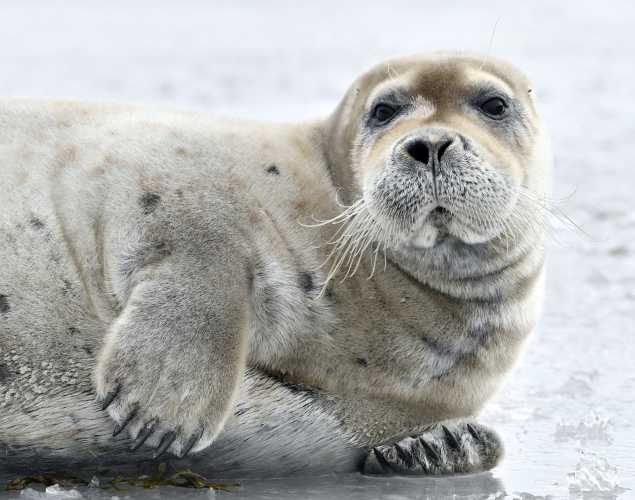
Comparative Muscle Physiology of Ringed, Bearded, and Spotted Seals from the Bering and Chukchi Seas
- Behavior
- Foraging
- Climate change
Abstract
The physiological properties of marine mammal skeletal muscle are foundational in defining diving and foraging capacities. Further, these parameters can be useful when assessing the behavioral flexibility of species faced with environmental change or disturbance. Herein, we define species- and age-specific muscle physiology for three ice-associated seal species experiencing Arctic warming. Specifically, we evaluated myoglobin content ([Mb]), nonbicarbonate buffering capacity (β), and fiber type profiles of a major locomotor muscle, the longissimus dorsi. Muscle samples were obtained from subsistence harvested ringed (Pusa hispida; n = 11), bearded (Erignathus barbatus; n = 41), and spotted (Phoca largha; n = 12) seals of all ages in the Bering and Chukchi Seas. Adult ringed seals had the highest [Mb] (6.67 ± 0.20 g 100 g wet tissue-1), followed by spotted (5.38 ± 0.29 g 100 g wet tissue-1) and bearded (4.55 ± 0.07 g 100 gwet tissue-1) seals. [Mb] increased with age for all species, but rates of increase differed by species. In contrast, β was similar for all species and age classes. We documented higher proportions of fast-twitch relative to slow-twitch fibers in these species, and fiber type proportions did not differ significantly with age. Adult bearded seals exhibited the greatest proportion of fasttwitch fibers (68.7 ± 1.5%), followed by ringed (59.0 ± 4.8%) and spotted (55.1 ± 2.1%) seals. Overall, our data suggest a strong link between muscle physiology, diving behavior, and life history strategies, and provide insight into the physiological capacities of these potentially vulnerable species.
Tengler, M.L., Dearolf, J., Bryan, A.L., Reichmuth, C. and Thometz, N.M., 2024. Comparative Muscle Physiology of Ringed (Pusa hispida), Bearded (Erignathus barbatus), and Spotted (Phoca largha) Seals from the Bering and Chukchi Seas. Aquatic Mammals, 50(3), pp.181-198.
Related Publications
{"image":"\/Animals\/Patients\/Harbor seals\/hs-by-bill-hunnewell-c-the-marine-mammal-center.jpg","alt":"harbor seal in a life preserver enrichment item","title":"Enrichment as a Tool for Rehabilitating Harbor Seals","link_url":"https:\/\/www.marinemammalcenter.org\/publications\/enrichment-as-a-tool-for-rehabilitating-harbor-seals","label":"Research Paper"}

{"image":"\/Animals\/Wild\/Harbor porpoise\/cropped-images\/harbor-porpoises-foraging-by-marc-webber-c-the-marine-mammal-center-4-0-1276-996-1618438446.jpg","alt":"harbor porpoises eating a large fish","title":"Prey-Related Suffocation in Harbor Porpoises","link_url":"https:\/\/www.marinemammalcenter.org\/publications\/prey-related-suffocation-in-harbor-porpoises","label":"Research Paper"}

{"image":"\/Animals\/Wild\/Harbor porpoise\/cropped-images\/harbor-porpoises-aerial-view-badge-by-marc-webber-c-the-marine-mammal-center-0-88-1280-999-1618509985.jpg","alt":"Harbor porpoises seen from above","title":"Coevolution of Asymmetric and Spiraled Genitalia with Unique Mating Behavior","link_url":"https:\/\/www.marinemammalcenter.org\/publications\/coevolution-of-asymmetric-and-spiraled-genitalia-with-unique-mating-behavior","label":"Research Paper"}

Coevolution of Asymmetric and Spiraled Genitalia with Unique Mating Behavior
Read More{"image":"\/Animals\/Wild\/Harbor porpoise\/harbor-porpoise-shutterstock-2.jpg","alt":"harbor porpoise","title":"Harbor Porpoises Catching and Handling Large Fish","link_url":"https:\/\/www.marinemammalcenter.org\/publications\/harbor-porpoises-catching-and-handling-large-fish","label":"Research Paper"}

Related News
{"image":"\/Animals\/Wild\/Hawaiian monk seal\/cropped-images\/hms-wild-photo-1-c-noaa-pifsc-hmsrp-35-0-1270-992-1759760452.jpg","alt":"A Hawaiian monk seal rests on its side on a sandy beach.","title":"Where Do Hawaiian Monk Seals Live? And Other \u2018\u012alio Holo I Ka Uaua Trivia","link_url":"https:\/\/www.marinemammalcenter.org\/news\/where-do-hawaiian-monk-seals-live-and-other-ilio-holo-i-ka-uaua-trivia","label":"News Update","date":"2025-10-06 00:00:00"}

Where Do Hawaiian Monk Seals Live? And Other ‘Īlio Holo I Ka Uaua Trivia
October 6, 2025
Read More{"image":"\/Animals\/Patients\/Elephant seals\/cropped-images\/es-hoffman47927-photo-by-bill-hunnewell-c-the-marine-mammal-center-124-0-1270-992-1748384535.jpg","alt":"An An elephant seal\u2019s face with long black whiskers and wide eyes emerges from the water. ","title":"Adaptations of the Deep: Seal Whiskers and Eyes","link_url":"https:\/\/www.marinemammalcenter.org\/news\/adaptations-of-the-deep-seal-whiskers-and-eyes","label":"Patient Update","date":"2025-05-28 02:00:00"}

{"image":"\/Animals\/Wild\/Humpback whale\/cropped-images\/humpback-whale-sea-lions-photo-c-bill-hunnewell-102-0-1270-992-1743014972.jpg","alt":"A California sea lion jumps out of the ocean next to a humpback whale showing its tail and another whale showing its back.","title":"What is the Loudest Animal on Earth? And Other Animal Trivia","link_url":"https:\/\/www.marinemammalcenter.org\/news\/what-is-the-loudest-animal-on-earth-and-other-animal-trivia","label":"News Update","date":"2025-03-26 07:00:00"}

{"image":"\/Animals\/Wild\/Guadalupe fur seal\/cropped-images\/gfs-wild-photo-by-marc-webber-193-0-1270-992-1739906952.jpg","alt":"A Guadalupe fur seal floats in the water with its flippers raised. ","title":"Your Visual Guide to Sea Lion and Seal Behavior","link_url":"https:\/\/www.marinemammalcenter.org\/news\/your-visual-guide-to-sea-lion-and-seal-behavior","label":"News Update","date":"2025-02-18 02:00:00"}


